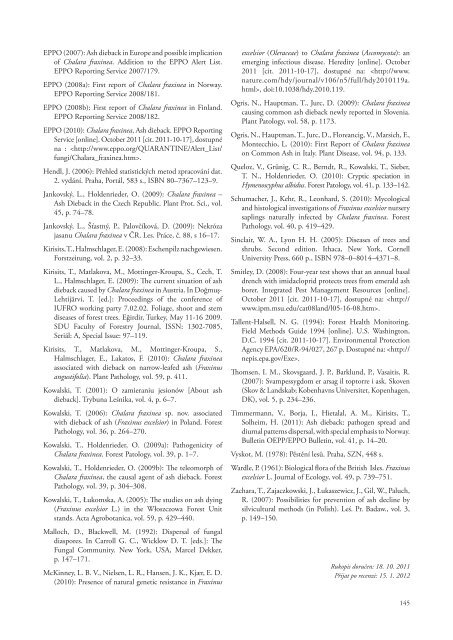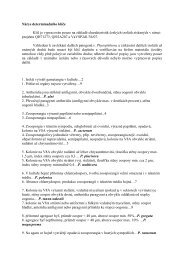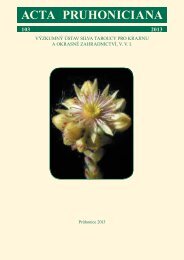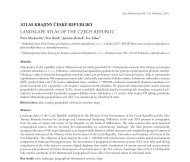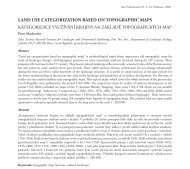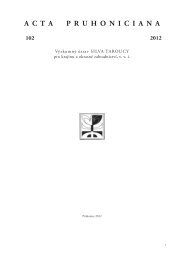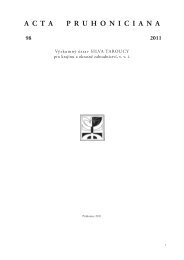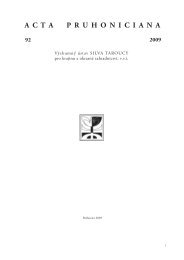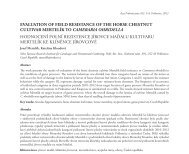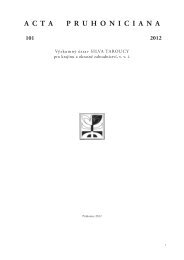na fakt, že patogen byl ve studovaném území detekován poprvév r. 2009 (Černý, unpubl.) a v ČR v r. 2007 (Jankovský,Holdenrieder, 2009). To sice mohlo být způsobeno částečněpřehlížením <strong>pro</strong>blému, ale nepochybně to rovněž souvisís mnohokrát zmiňovanou rychlostí invaze a s faktem, že se Ch.fraxinea velmi pravděpodobně šíří vzduchem (např. Kowalski,Holdenrieder, 2009b; Queloz et al., 2010). Patogen byl ve sledovanémúzemí zjištěn ve všech kategoriích výsadeb a téměřv 94 % zkoumaných ploch, což je v souladu např. s výsledkyKirisitse a Halmschlagera (2008) a Kowalského a Łukomské(2005). Tento fakt ve spojitosti s náhlým vzestupem chorobyopět podporuje teorii o šíření patogenu vzduchem.Na druhou stranu se ukázalo, že napadení jasanů v různýchkategoriích porostů průkazně kolísá – nejmenší podíl napadeníbyl zjištěn v kategorii solitérní výskyt a lesní porost, největšípak v kategorii břehový porost a jasanová olšina. To můžesouviset samozřejmě s celou řadou faktorů – např. s celkovýmobjemem korun jasanů na ploše, který je u nejvíce poškozenýchkategorií vyšší (viz tab. 2). Lze předpokládat, že meziobjemem korun jasanů a četností výskytu choroby existujepozitivní závislost. Objem korun odpovídá množství kolonizovatelnéhosubstrátu – jinak také receptivní ploše, na kterése mohou zachytit askospory šířící se vzduchem. Objemkorun rovněž koresponduje s množstvím opadlého substrátu,na kterém patogen pravděpodobně dokončuje vývoj. Askosporyuvolněné z apothecií narostlých na opadlých řapícíchslouží jako primární infekční inokulum, kterým jsou dáleinfikovány listy a výhony v korunách (Timmermann et al.,2011). Pokud by tato skutečnost byla potvrzena, bylo by možnéuvažovat o silné pozitivní zpětné vazbě a rychlém nárůstupoškození porostu (kdy by byly nejvíce postiženy spodní částikorun), <strong>pro</strong>tože lze předpokládat, že největší množství infekčníhoinokula bude zachyceno v krátké vzdálenosti od jehozdroje (Malloch, Blackwell, 1992).Dalším faktorem, který mohl být příčinou vyššího napadeníjasanových olšin a břehových porostů, je fakt, že jsou vícevázány na vlhčí <strong>pro</strong>středí. Délepřetrvávající vlhkost <strong>pro</strong>středímůže chránit spory před vyschnutím a stimulovat klíčení(Timmermann et al., 2011), může tak dojít rychlejšímu rozvojichoroby, podobně jako např. u antraknózy platanu a jinýchchorob listů a výhonů (Sinclair et Lyon, 2005). Vyššívlhkost <strong>pro</strong>středí může rovněž být ovlivněna vyšším zápojemstromového patra na ploše a v jejím okolí a geomorfologiíterénu. Vyšší zápoj vícedruhového porostu (např. v lesníchporostech či jasanových olšinách) může ovšem na druhoustranu teoreticky snížit pravděpodobnost uchycení patogenuna ploše (askospory patogenu mají menší pravděpodobnost,že dopadnou na vhodný substrát). Vliv na uchycení patogenumůže mít např. také expozice a relativní nadmořská výška aj.Metodika výběru lokalit byla sice nastavena tak, aby pokudmožno nedocházelo k velkému zkreslení v důsledku působenítohoto faktoru, nicméně byla vždy identifikována nejbližšíohniska výskytu choroby v okolí sledovaných ploch, jejichvzdálenost a směr.Všechny výše zmíněné a některé další faktory byly při terénnímsběru dat zohledněny a jejich variabilita byla zaznamenána.Jejich vyhodnocení <strong>pro</strong>běhne v následujících měsících.ZÁVĚRNa základě průzkumu 80 porostů reprezentujících celou škáluvýskytu jasanu na území CHKO Lužické hory bylo zjištěno,že patogen Chalara fraxinea je na území značně rozšířena choroba, kterou způsobuje – nekróza jasanu – se vyskytujev téměř 94 % zkoumaných ploch. Dále bylo zjištěno, že průměrnáúroveň poškození porostů je 10,30 %, což je vzhledemke krátké době od počátku invaze alarmující hodnota. Bylozjištěno, že průměrné poškození korun jasanů na zkoumanýchplochách dosáhlo 4 143,11 m 3 na 1 ha porostu. Nejmenšíobjemy poškození lze identifikovat v kategorii solitérnívýskyt, kde bylo poškozeno v průměru 591,89 m 3 /ha (4,42%celkového objemu korun). Poměrně málo se nekróza jasanuvyskytovala i v lesních porostech – průměrný objem poškozeníčinil 1 518,45 m 3 /ha (5,50 %). Největší objemy poškozeníbyly identifikovány v jasanových olšinách: 6 852,89 m 3 /ha(14,14%) a v břehových porostech, kde poškození dosáhlov průměru 8 426,23 m 3 /ha (15,22 %).Poškození jednotlivých kategorií porostů se mezi sebou průkazněliší (p < 0,01) a lze jednoznačně říci, že v CHKO Lužickéhory jsou nejméně napadeny solitérní jasany a lesní porostya naopak nejvíce jsou napadeny porosty břehové a jasanovéolšiny (p < 0,01).Práce na <strong>pro</strong>jektu budou dále pokračovat – v následujícím obdobíbudou zkoumány faktory <strong>pro</strong>středí, které mohly ovlivnitintenzitu choroby v různých typech porostů.PoděkováníPráce byla podpořena <strong>pro</strong>jekty Ministerstva zemědělství Českérepubliky č. NAZV QI92A207 a Ministerstva školství,mládeže a tělovýchovy č. ČZU IGAFLD201113. Dále bychomchtěli poděkovat za spolupráci SCHKO Lužické hory,zejména pak ing. Alexandru Hrozkovi za veškerou pomoc připrůzkumu území a SCHKO Labské pískovce.LITERATURABakys, R., Vasaitis, R., Barklund, P., Ihrmark, K., Stenlid,J. (2009): Investigations concerning the role of Chalarafraxinea in declining Fraxinus excelsior. Plant Pathology,vol. 58, p. 284–292.Černý, K. (2011): Nebezpečné patogeny lesních dřevinPhytophthora alni a Chalara fraxinea: rozšíření, význama možná rizika vyplývající z jejich zdomácnění. Zpr. Ochr.Lesa, č. 15, s. 71–75.Eichhorn, J., Roskams, P., Ferretti, M., Mues, V., Szepesi, A.,Durrant, D. (2010): International Co-operative Programmeon Assessment and Monitoring of Air Pollution Effects onForest (ICP Forest), part IV Visual Assessment of CrownCondition and Damaging Agents. Hamburg, UNECEICP Forest Programe Co-ordinating Centre, 47 p.144
EPPO (2007): Ash dieback in Europe and possible implicationof Chalara fraxinea. Addition to the EPPO Alert List.EPPO Reporting Service 2007/179.EPPO (2008a): First report of Chalara fraxinea in Norway.EPPO Reporting Service 2008/181.EPPO (2008b): First report of Chalara fraxinea in Finland.EPPO Reporting Service 2008/182.EPPO (2010): Chalara fraxinea, Ash dieback. EPPO ReportingService [online]. October 2011 [cit. 2011-10-17], dostupnéna : .Hendl, J. (2006): Přehled statistických metod zpracování dat.2. vydání. Praha, Portál, 583 s., ISBN 80–7367–123–9.Jankovský, L., Holdenrieder, O. (2009): Chalara fraxinea –Ash Dieback in the Czech Republic. Plant Prot. Sci., vol.45, p. 74–78.Jankovský, L., Šťastný, P., Palovčíková, D. (2009): Nekrózajasanu Chalara fraxinea v ČR. Les. Práce, č. 88, s 16–17.Kirisits, T., Halmschlager, E. (2008): Eschenpilz nachgewiesen.Forstzeitung, vol. 2, p. 32–33.Kirisits, T., Matlakova, M., Mottinger-Kroupa, S., Cech, T.L., Halmschlager, E. (2009): The current situation of ashdieback caused by Chalara fraxinea in Austria. In Doğmuş-Lehtijärvi, T. [ed.]: Proceedings of the conference ofIUFRO working party 7.02.02. Foliage, shoot and stemdiseases of forest trees. Eğirdir, Turkey, May 11-16 2009.SDU Faculty of Forestry Journal, ISSN: 1302-7085,Seriál: A, Special Issue: 97–119.Kirisits, T., Matlakova, M., Mottinger-Kroupa, S.,Halmschlager, E., Lakatos, F. (2010): Chalara fraxineaassociated with dieback on narrow-leafed ash (Fraxinusangustifolia). Plant Pathology, vol. 59, p. 411.Kowalski, T. (2001): O zamieraniu jesionów [About ashdieback]. Trybuna Leśnika, vol. 4, p. 6–7.Kowalski, T. (2006): Chalara fraxinea sp. nov. associatedwith dieback of ash (Fraxinus excelsior) in Poland. ForestPathology, vol. 36, p. 264–270.Kowalski, T., Holdenrieder, O. (2009a): Pathogenicity ofChalara fraxinea. Forest Patology, vol. 39, p. 1–7.Kowalski, T., Holdenrieder, O. (2009b): The teleomorph ofChalara fraxinea, the causal agent of ash dieback. ForestPathology, vol. 39, p. 304–308.Kowalski, T., Łukomska, A. (2005): The studies on ash dying(Fraxinus excelsior L.) in the Włoszczowa Forest Unitstands. <strong>Acta</strong> Agrobotanica, vol. 59, p. 429–440.Malloch, D., Blackwell, M. (1992): Dispersal of fungaldiaspores. In Carroll G. C., Wicklow D. T. [eds.]: TheFungal Community. New York, USA, Marcel Dekker,p. 147–171.McKinney, L. B. V., Nielsen, L. R., Hansen, J. K., Kjær, E. D.(2010): Presence of natural genetic resistance in Fraxinusexcelsior (Oleraceae) to Chalara fraxinea (Ascomycota): anemerging infectious disease. Heredity [online]. October2011 [cit. 2011-10-17], dostupné na: , doi:10.1038/hdy.2010.119.Ogris, N., Hauptman, T., Jurc, D. (2009): Chalara fraxineacausing common ash dieback newly reported in Slovenia.Plant Patology, vol. 58, p. 1173.Ogris, N., Hauptman, T., Jurc, D., Floreancig, V., Marsich, F.,Montecchio, L. (2010): First Report of Chalara fraxineaon Common Ash in Italy. Plant Disease, vol. 94, p. 133.Queloz, V., Grünig, C. R., Berndt, R., Kowalski, T., Sieber,T. N., Holdenrieder, O. (2010): Cryptic speciation inHymenoscyphus albidus. Forest Patology, vol. 41, p. 133–142.Schumacher, J., Kehr, R., Leonhard, S. (2010): Mycologicaland histological investigations of Fraxinus excelsior nurserysaplings naturally infected by Chalara fraxinea. ForestPathology, vol. 40, p. 419–429.Sinclair, W. A., Lyon H. H. (2005): Diseases of trees andshrubs. Second edition. Ithaca, New York, CornellUniversity Press, 660 p., ISBN 978–0–8014–4371–8.Smitley, D. (2008): Four-year test shows that an annual basaldrench with imidacloprid <strong>pro</strong>tects trees from emerald ashborer. Integrated Pest Management Resources [online].October 2011 [cit. 2011-10-17], dostupné na: .Tallent-Halsell, N. G. (1994): Forest Health Monitoring.Field Methods Guide 1994 [online]. U.S. Washington,D.C. 1994 [cit. 2011-10-17]. Environmental ProtectionAgency EPA/620/R-94/027, 267 p. Dostupné na: .Thomsen, I. M., Skovsgaard, J. P., Barklund, P., Vasaitis, R.(2007): Svampessygdom er arsag il toptorre i ask. Skoven(Skov & Landskab; Kobenhavns Universitet, Kopenhagen,DK), vol. 5, p. 234–236.Timmermann, V., Borja, I., Hietalal, A. M., Kirisits, T.,Solheim, H. (2011): Ash dieback: pathogen spread anddiurnal patterns dispersal, with special emphasis to Norway.Bulletin OEPP/EPPO Bulletin, vol. 41, p. 14–20.Vyskot, M. (1978): Pěstění lesů. Praha, SZN, 448 s.Wardle, P. (1961): Biological flora of the British Isles. Fraxinusexcelsior L. Journal of Ecology, vol. 49, p. 739–751.Zachara, T., Zajaczkowski, J., Łukaszewicz, J., Gil, W., Paluch,R. (2007): Possibilities for prevention of ash decline bysilvicultural methods (in Polish). Leś. Pr. Badaw., vol. 3,p. 149–150.Rukopis doručen: 18. 10. 2011Přijat po recenzi: 15. 1. 2012145
- Page 1 and 2:
A C T AP R U H O N I C I A N A100 2
- Page 3 and 4:
OBSAHVýzkumný ústav Silva Tarouc
- Page 5 and 6:
Acta Pruhoniciana 100: 5-27, Průho
- Page 7 and 8:
trvalé zeleně ve venkovské kraji
- Page 9 and 10:
ka přirozených lesů ČR, která
- Page 11 and 12:
Odrůda Rod/druh Šlechtitelské os
- Page 13 and 14:
Publikace v periodikách s impaktem
- Page 15 and 16:
V oblasti výměny rostlinného mat
- Page 17 and 18:
(aktidionu) proti padlí jabloňov
- Page 19 and 20:
28/1974Hieke, K.: Dřeviny zámeck
- Page 21 and 22:
55/1988Benetka, V., Kodýtek, K.: V
- Page 23 and 24:
Peš, T.: Kolekce druhů rodu Pinus
- Page 25 and 26:
Drobilová, L.: Evaluating ecologic
- Page 27:
Havlíčková, K., Knápek, J.: Eko
- Page 30 and 31:
vyhovující, a to jak z hlediska l
- Page 32 and 33:
Převodní klíč pro úpravu zákl
- Page 34 and 35:
V tabulce 1 jsou vedle údaje o cen
- Page 36 and 37:
ní jehličnatých stromů na trval
- Page 39 and 40:
Tab. 7 Postup výpočtu základní
- Page 41 and 42:
Acta Pruhoniciana 100: 41-49, Průh
- Page 43 and 44:
Databáze (mapy) BPEJ. Komoditní a
- Page 45 and 46:
Obr. 1 Cenové mapy biomasy z energ
- Page 47 and 48:
Cenové mapy vybraných zdrojů bio
- Page 49:
V případě, že nebude pěstován
- Page 52 and 53:
z výsledků počáteční fáze v
- Page 54 and 55:
Tab. 2 Sortiment vrb a topolů v po
- Page 56 and 57:
Graf 1 Hektarové výnosy sušiny t
- Page 58 and 59:
Tab. 6 Růstové parametry topolů
- Page 60 and 61:
Obr. 5 Klon topolu P_070 při prvn
- Page 62 and 63:
Trnka, M., Trnka, M. jr., Fialová,
- Page 64 and 65:
Obr. 1 Poloha zkoumaného území v
- Page 66 and 67:
(např. požární nebo koupališt
- Page 68 and 69:
68Obr. 3 Typy procesů změn využ
- Page 70 and 71:
70Obr. 4 Typy procesů změn využ
- Page 72 and 73:
Haase, D., Walz, U., Neubert, M., R
- Page 74 and 75:
ministrativně i přírodně vymeze
- Page 76 and 77:
výškou 271 m n. m. a středním s
- Page 78 and 79:
úvalu a Ždánickém lese, zatímc
- Page 80 and 81:
Obr. 4 Využití krajiny v geomorfo
- Page 82 and 83:
Obr. 10 Trajektorie změn využití
- Page 84 and 85:
vém úseku) věnovali Havlíček e
- Page 86 and 87:
Skanes, H. M., Bunce, R. G. H. (199
- Page 88 and 89:
ústavu Jána Lipského v Banské B
- Page 90 and 91:
zobrazení (do roku 1934) a v letec
- Page 92 and 93:
Obr. 6 Využití toposekcí 1 : 25
- Page 94 and 95: Obr. 9 Ukázka dvoubarevné německ
- Page 96 and 97: Tab. 1 Označení a rozměry vydáv
- Page 99 and 100: Acta Pruhoniciana 100: 99-107, Prů
- Page 101 and 102: Inventarium (1807, březen) - ručn
- Page 103 and 104: Tabulka 1 Přehled domácích dřev
- Page 105 and 106: Salix purpurea L. cv Salix purea ad
- Page 107 and 108: 44) Křesadlová (2004, s. 41, 60)
- Page 109 and 110: Acta Pruhoniciana 100: 109-114, Pr
- Page 111 and 112: Tab. 2 Porovnávané listové a kv
- Page 113 and 114: ‘Perkeo’ ‘Ra’ a ‘Endeavou
- Page 115 and 116: Acta Pruhoniciana 100: 115-122, Pr
- Page 117 and 118: ostlin, tak v rámci skupiny shodn
- Page 119 and 120: Obr. 1 Miscanthus sinensis (A. Baro
- Page 121 and 122: k poškození i zralých (loňskýc
- Page 123 and 124: Acta Pruhoniciana 100: 123-130, Pr
- Page 125 and 126: Tab. 1 Přehled a vyhodnocení chov
- Page 127 and 128: Obr. 2 Seiridium cardinale na Cupre
- Page 129 and 130: Obr. 10 Rhododendron necrotic rings
- Page 131 and 132: Acta Pruhoniciana 100: 131-135, Pr
- Page 133 and 134: Obr. 1 Silně náchylná a odolná
- Page 135 and 136: při výběru nejodolnějších ros
- Page 137 and 138: Acta Pruhoniciana 100: 137-145, Pr
- Page 139 and 140: typech společenstev a výsadeb, kd
- Page 141 and 142: Plocha č. Lokalizace Souřadnice N
- Page 143: ná úroveň poškození porostů j
- Page 147 and 148: Acta Pruhoniciana 100: 147-153, Pr
- Page 149 and 150: fikaci nekódující oblasti cpDNA
- Page 151 and 152: Dopěstování rostlin v podmínká
- Page 153 and 154: Wachowiak, W., Stephan, B. R., Schu
- Page 155 and 156: Acta Pruhoniciana 100: 155-160, Pr
- Page 157 and 158: Obr. 1 P. vernalis rostlina se zral
- Page 159 and 160: Tab. 4 Repatriace a výsadby na gen
- Page 161 and 162: Acta Pruhoniciana 100: 161-166, Pr
- Page 163 and 164: Ke statistickému zpracování gene
- Page 165 and 166: Tab. 5 Populačněgenetické parame
- Page 167 and 168: 167


